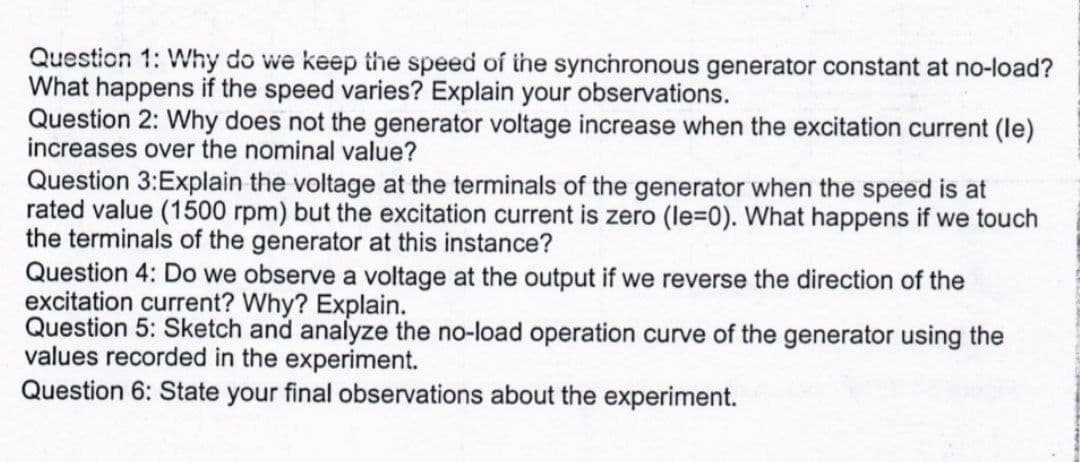Questicn 1: Why do we keep the speed of ihe synchronous generator constant at no-load? What happens if the speed varies? Explain your observations. Question 2: Why does not the generator voltage increase when the excitation current (le) increases over the nominal value? Question 3:Explain the voltage at the terminals of the generator when the speed is at
Questicn 1: Why do we keep the speed of ihe synchronous generator constant at no-load? What happens if the speed varies? Explain your observations. Question 2: Why does not the generator voltage increase when the excitation current (le) increases over the nominal value? Question 3:Explain the voltage at the terminals of the generator when the speed is at
Introductory Circuit Analysis (13th Edition)
13th Edition
ISBN:9780133923605
Author:Robert L. Boylestad
Publisher:Robert L. Boylestad
Chapter1: Introduction
Section: Chapter Questions
Problem 1P: Visit your local library (at school or home) and describe the extent to which it provides literature...
Related questions
Question
i need the answer quickly

Transcribed Image Text:Questicn 1: Why do we keep the speed of the synchronous generator constant at no-load?
What happens if the speed varies? Explain your observations.
Question 2: Why does not the generator voltage increase when the excitation current (le)
increases over the nominal value?
Question 3:Explain the voltage at the terminals of the generator when the speed is at
rated value (1500 rpm) but the excitation current is zero (le=0). What happens if we touch
the terminals of the generator at this instance?
Question 4: Do we observe a voltage at the output if we reverse the direction of the
excitation current? Why? Explain.
Question 5: Sketch and analyze the no-load operation curve of the generator using the
values recorded in the experiment.
Question 6: State your final observations about the experiment.
Expert Solution
This question has been solved!
Explore an expertly crafted, step-by-step solution for a thorough understanding of key concepts.
Step by step
Solved in 3 steps

Knowledge Booster
Learn more about
Need a deep-dive on the concept behind this application? Look no further. Learn more about this topic, electrical-engineering and related others by exploring similar questions and additional content below.Recommended textbooks for you

Introductory Circuit Analysis (13th Edition)
Electrical Engineering
ISBN:
9780133923605
Author:
Robert L. Boylestad
Publisher:
PEARSON

Delmar's Standard Textbook Of Electricity
Electrical Engineering
ISBN:
9781337900348
Author:
Stephen L. Herman
Publisher:
Cengage Learning

Programmable Logic Controllers
Electrical Engineering
ISBN:
9780073373843
Author:
Frank D. Petruzella
Publisher:
McGraw-Hill Education

Introductory Circuit Analysis (13th Edition)
Electrical Engineering
ISBN:
9780133923605
Author:
Robert L. Boylestad
Publisher:
PEARSON

Delmar's Standard Textbook Of Electricity
Electrical Engineering
ISBN:
9781337900348
Author:
Stephen L. Herman
Publisher:
Cengage Learning

Programmable Logic Controllers
Electrical Engineering
ISBN:
9780073373843
Author:
Frank D. Petruzella
Publisher:
McGraw-Hill Education

Fundamentals of Electric Circuits
Electrical Engineering
ISBN:
9780078028229
Author:
Charles K Alexander, Matthew Sadiku
Publisher:
McGraw-Hill Education

Electric Circuits. (11th Edition)
Electrical Engineering
ISBN:
9780134746968
Author:
James W. Nilsson, Susan Riedel
Publisher:
PEARSON

Engineering Electromagnetics
Electrical Engineering
ISBN:
9780078028151
Author:
Hayt, William H. (william Hart), Jr, BUCK, John A.
Publisher:
Mcgraw-hill Education,